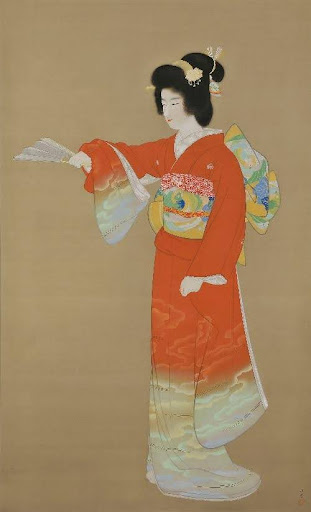10.序の舞(Jo no Mai)
松園が生涯をかけて追求した「気品ある女性像」の到達点

《序の舞》は、1936年上村松園が61歳の円熟期に描いた代表作。彼女自身が「私の理想の女性の最高のもの」と語ったほどの力作で、重要文化財に指定されている。女性は扇を逆手に持ち、袖が翻る姿勢で能の「仕舞」の一場面を披露している。朱色の大振袖には吉兆を示す「彩雲模様」が描かれ、五つ紋入りの格式高い装い、鳳凰紋の丸帯を締め、髪型は文金高島田。これは江戸時代、武家の姫君にのみ許された高貴な髪型である。モデルは松園の義理の娘・たね子を中心に、謡の先生の娘や弟子たちを組み合わせて理想の女性像を構築した。髪結いも京都で最も品の良い職人に依頼したと語られています。「何ものにも犯されない、女性のうちにひそむ強い意志を、この絵に表現したかった」と松園自身が語っている。
Jo no Mai (Noh Dance Prelude)
The culmination of her lifelong pursuit of graceful femininity
Painted in 1936 at the age of 61, Jo no Mai is considered one of Shōen Uemura’s most representative works from her mature years. She herself described it as “the finest embodiment of my ideal woman,” and the work has been designated an Important Cultural Property.
The painting captures a moment from a shimai (a simplified Noh performance), with a woman holding a fan in reverse grip, her sleeve fluttering mid-motion. She wears a vibrant red furisode adorned with auspicious saiun (iridescent clouds) motifs, a formal five-crested ensemble, and a maru-obi featuring phoenix patterns. Her hairstyle, bunkin takashimada, was traditionally reserved for noblewomen of samurai lineage during the Edo period.
To construct her ideal feminine image, Uemura combined elements from several models, including her daughter-in-law Taneko, the daughter of her Noh chant teacher, and other female disciples. She even commissioned Kyoto’s most refined hairdresser to style the model’s hair.
Uemura stated, “I wanted to express the indomitable will that lies quietly within a woman, untouched by anything.”
お問い合わせ
〒154-0024 東京都世田谷区三軒茶屋1-39-7